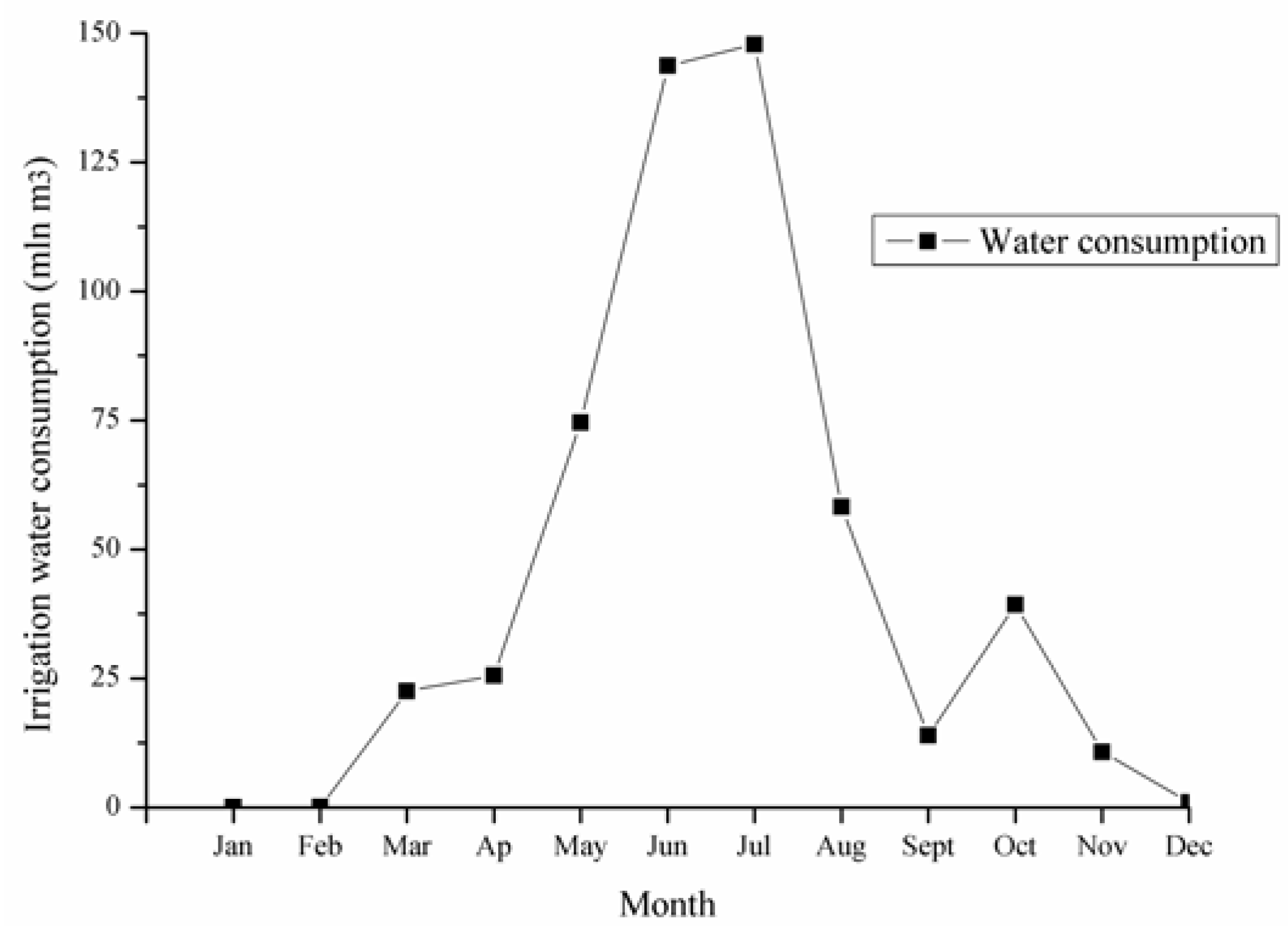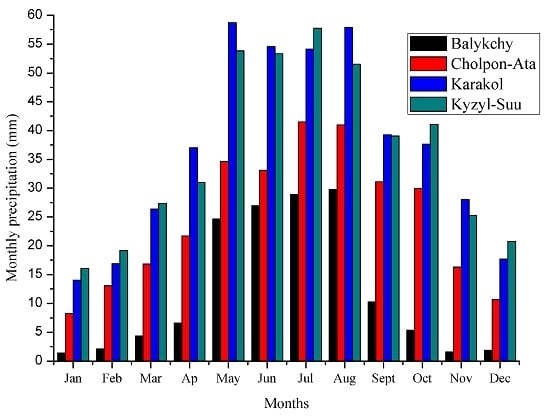Consideration of Water Uses for Its Sustainable Management, the Case of Issyk-Kul Lake, Kyrgyzstan
Abstract
:1. Introduction
2. Materials and Methods
2.1. Description of the Study Area
2.2. Data Collection and Analysis
3. Results
3.1. Issyk-Kul Lake Water Level and Supply
3.2. Annual Precipitation Variation
3.3. Main Issyk-Kul Lake Water Consumers
4. Discussion
4.1. Water Resources and Increasing Demand
4.2. Climate Change and Water
4.3. Water and Sustainability
5. Conclusions
Acknowledgments
Author Contributions
Conflicts of Interest
References
- Wilson, J.R.; Holst, N.; Rees, M. Determinants and patterns of population growth in water hyacinth. Aquat. Bot. 2005, 81, 51–67. [Google Scholar] [CrossRef]
- Vörösmarty, C.J.; Green, P.; Salisbury, J.; Lammers, R.B. Global water resources: Vulnerability from climate change and population growth. Science 2000, 289, 284–288. [Google Scholar] [CrossRef] [PubMed]
- Fullerton, T.M.; Elias, A. Short-term water consumption dynamics in El Paso, Texas. Water Resour. Res. 2004, 40. [Google Scholar] [CrossRef]
- Rost, S.; Gerten, D.; Bondeau, A.; Lucht, W.; Rohwer, J.; Schaphoff, S. Agricultural green and blue water consumption and its influence on the global water system. Water Resour. Res. 2008, 44. [Google Scholar] [CrossRef]
- Avramoski, O. The Role of Public Participation and Citizen Involvement in Lake Basin Management. Available online: http://www.worldlakes.org/uploads/Thematic_Paper_PP_16Feb04.pdf (assessed on 14 April 2004).
- Koop, S.H.; van Leeuwen, C.J. Assessment of the sustainability of water resources management: A critical review of the city blueprint approach. Water Resour. Manag. 2015, 29, 5649–5670. [Google Scholar] [CrossRef]
- Kundzewicz, Z.W.; Mata, L.J.; Arnell, N.W.; Döll, P.; Jimenez, B.; Miller, K.; Oki, T.; Şen, Z.; Shiklomanov, I. The implications of projected climate change for freshwater resources and their management. Hydrol. Sci. J. 2008, 53, 3–10. [Google Scholar] [CrossRef]
- Piao, S.; Ciais, P.; Huang, Y.; Shen, Z.; Peng, S.; Li, J.; Zhou, L.; Liu, H.; Ma, Y.; Ding, Y.; et al. The impacts of climate change on water resources and agriculture in China. Nature 2010, 467, 43–51. [Google Scholar] [CrossRef] [PubMed]
- Velazquez, E. An input–output model of water consumption: Analysing intersectoral water relationships in Andalusia. Ecol. Econ. 2006, 56, 226–240. [Google Scholar] [CrossRef]
- Jellison, R.; Zadereev, Y.S.; DasSarma, P.A.; Melack, J.M.; Rosen, M.R.; Degermendzhy, A.G.; DasSarma, S.; Zambrana, G. Conservation and Management Challenges of Saline Lakes: A Review of Five Experience Briefs. Lake Basin Management Initiative: Thematic Paper. Available online: http://citeseerx.ist.psu.edu/viewdoc/download?doi=10.1.1.552.9109&rep=rep1&type=pdf (assessed on 14 July 2016).
- Ramana, R.V.; Krishna, B.; Kumar, S.R.; Pandey, N.G. Monthly rainfall prediction using wavelet neural network analysis. Water Resour. Manag. 2013, 27, 3697–3711. [Google Scholar] [CrossRef]
- Polunin, N.V.C. Aquatic Ecosystems: Trends and Global Prospects; Cambridge University Press: Cambridge, UK, 2008; pp. 94–110. [Google Scholar]
- Atadjanov, S.; Tulegabylov, N.; Bekkulova, D.; Baidakova, N.; Grebnev, V. The National Report on the State of the Environment of the Kyrgyz Republic for 2006–2011; United Nations Development Programme (UNDP): New York, NY, USA, 2012. [Google Scholar]
- Klerx, J.; Imanackunov, B. Lake Issyk-Kul: Its Natural Environment; Springer Science & Business Media: Berlin, Germany, 2002; Volume 13. [Google Scholar]
- Mamatkanov, D.M.; Bazhanov, L.V.; Romanovsky, V.V. Water Resources of Kyrgyzstan in Modern Days; Ilim: Bishkek, Kyrgyz Republic, 2006. [Google Scholar]
- Asykulov, T. The Socio-Economics and Natural Environment of Eastern Kyrgyzstan and Development Issues of Biosphere Reserve Issyk-Kul. Ph.D. Thesis, University Graysvald, Graysvald, Germany, 2002. [Google Scholar]
- Giralt, S.; Klerkx, J.; Riera, S.; Julia, R.; Lignier, V.; Beck, C.; De Batist, M.; Kalugin, I. Recent Paleoenvironmental Evolution of Lake Issyk-Kul, in Lake Issyk-Kul: Its Natural Environment; Springer: Berlin, Germany, 2002; pp. 125–145. [Google Scholar]
- Vollmer, M.K.; Weiss, R.F.; Schlosser, P.; Williams, R.T. Deep-water renewal in Lake Issyk-Kul. Geophys. Res. Lett. 2002, 29. [Google Scholar] [CrossRef]
- Gavshin, V.M.; Sukhorukov, F.V.; Bobrov, V.A.; Melgunov, M.S.; Miroshnichenko, L.V.; Klerkx, J.; Kovalev, S.I.; Romashkin, P.A. Chemical composition of the uranium tail storages at Kadji-Sai (southern shore of Issyk-Kul lake, Kyrgyzstan). Water Air Soil Pollut. 2004, 154, 71–83. [Google Scholar] [CrossRef]
- Wang, G.-Y.; Shen, Y.-P.; Qin, D.-H. Issyk-Kul Lake Level Fluctuation during 1860–2005 and Its Relation with Regional Climatic and Hydrological Changes. J. Glaciol. Geocryol. 2006, 28, 854–860. [Google Scholar]
- Tsigelnaya, I.D. Issyk-Kul Lake. Enclosed Seas and Large Lakes of Eastern Europe and Middle Asia; SPB Academic Publishing: Amsterdam, The Netherlands, 1995; Volume 199, p. 229. [Google Scholar]
- Peeters, F.; Finger, D.; Hofer, M.; Brennwald, M.; Livingstone, D.M.; Kipfer, R. Deep-water renewal in Lake Issyk-Kul driven by differential cooling. Limnol. Oceanogr. 2003, 48, 1419–1431. [Google Scholar] [CrossRef]
- Uulu Salamat, A.; Abuduwaili, J.; Shaidyldaeva, N. Impact of climate change on water level fluctuation of Issyk-Kul Lake. Arab. J. Geosci. 2015, 8, 5361–5371. [Google Scholar] [CrossRef]
- Shnitnikov, A. Water balance variability of lakes Aral, Balkhash, Issyk-Kul and Chany. In Hydrology of Lakes; Adlard & Son Ltd., Bartholomew Press: Dorking, Surrey, 1973; pp. 130–140. [Google Scholar]
- De Batist, M.; Imbo, Y.; Vermeesch, P.; Klerkx, J.; Giralt, S.; Delvaux, D.; Lignier, V.; Beck, C.; Kalugin, I.; Abdrakhmatov, K.E. Bathymetry and sedimentary environments of Lake Issyk-Kul, Kyrgyz Republic (Central Asia): A large, high-altitude, tectonic lake. In Lake Issyk-Kul: Its Natural Environment; Springer: Berlin, Germany, 2002; pp. 101–123. [Google Scholar]
- Jailoobayev, A.; Neronova, T.; Nikolayenko, A.; Mirkhashimov, I. Water Quality Standards and Norms in Kyrgyz Republic; Regional Environmental Centre for Central Asia (CAREC): Almaty, Kazakhstan, 2009. [Google Scholar]
- Wang, G.Y.; Shen, Y.P.; Wang, N.L.; Wu, Q.B. The Effects of Climate Change and Human Activities on the Lake Level of the Issyk-Kul during the Past 100 Years. J. Glaciol. Geocryol. 2010, 32, 1097–1105. [Google Scholar]
- Baetov, R. Lake Issyk-Kul. Managing Lakes and their Basins for Sustainable Future; International Lake Environment Committee Foundation: Kusatsu, Japan, 2005; pp. 193–204. [Google Scholar]
- Propastin, P. Assessment of climate and human induced disaster risk over shared water resources in the Balkhash Lake drainage basin. In Climate Change and Disaster Risk Management; Springer: Berlin, Germany, 2013; pp. 41–54. [Google Scholar]
- Vollmer, M.K.; Weiss, R.F.; Williams, R.T.; Falkner, K.K.; Qiu, X.; Ralph, E.A.; Romanovsky, V.V. Physical and chemical properties of the waters of saline lakes and their importance for deep-water renewal: Lake Issyk-Kul, Kyrgyzstan. Geochim. Cosmochim. Acta 2002, 66, 4235–4246. [Google Scholar] [CrossRef]
- Fereres, E.; Soriano, M.A. Deficit irrigation for reducing agricultural water use. J. Exp. Bot. 2007, 58, 147–159. [Google Scholar] [CrossRef] [PubMed]
- Pereira, L.S.; Oweis, T.; Zairi, A. Irrigation management under water scarcity. Agric. Water Manag. 2002, 57, 175–206. [Google Scholar] [CrossRef]
- Afolayan, S.O.; Ogedengbe, K.; Lateef, S.A.; Akintola, O.A.; Oladele, O.J. Response of tomato (Lycopersicium lycopersicun, CV UC82B) to drip irrigation and planting conditions. Afr. J. Agric. Res. 2014, 9, 1543–1549. [Google Scholar]
- Lamek Nahayo, L.L.; Zhao, X. Consideration of Precipitation Variability Under Climate Change at Kaidu River Wateshed, China. East Afr. J. Sci. Technol. 2016, 6, 16–23. [Google Scholar]
- Klein Tank, A.M.G.; Peterson, T.C.; Quadir, D.A.; Dorji, S.; Zou, X.; Tang, H.; Santhosh, K.; Joshi, U.R.; Jaswal, A.K.; Kolli, R.K.; et al. Changes in daily temperature and precipitation extremes in central and south Asia. J. Geophys. Res. Atmos. 2006, 111, D16. [Google Scholar] [CrossRef]
- Rockström, J.; Karlberg, L.; Wani, S.P.; Barron, J.; Hatibu, N.; Oweis, T.; Bruggeman, A.; Farahani, J.; Qiang, Z. Managing water in rainfed agriculture—The need for a paradigm shift. Agric. Water Manag. 2010, 97, 543–550. [Google Scholar] [CrossRef]
- Bouman, B.; Tuong, T.P. Field water management to save water and increase its productivity in irrigated lowland rice. Agric. Water Manag. 2001, 49, 11–30. [Google Scholar] [CrossRef]
- Raadgever, G.; Mostert, E.; Van de Giesen, N. Learning from collaborative research in water management practice. Water Resour. Manag. 2012, 26, 3251–3266. [Google Scholar] [CrossRef]
- Ward, F.A.; Pulido-Velazquez, M. Water conservation in irrigation can increase water use. Proc. Natl. Acad. Sci. USA 2008, 105, 18215–18220. [Google Scholar] [CrossRef] [PubMed]
- National Statistics Committee of the Kyrgzy Republic (NSCKR). Human Population of the Issyk-Kul Basin Basin Lake Region; NSCKR: Bishkek, Kyrgyzstan, 2015. [Google Scholar]
- Antwi-Agyei, P.; Fraser, E.D.; Dougill, A.J.; Stringer, L.C.; Simelton, E. Mapping the vulnerability of crop production to drought in Ghana using rainfall, yield and socioeconomic data. Appl. Geogr. 2012, 32, 324–334. [Google Scholar] [CrossRef]
- Pereira Filho, A.J.; Carbone, R.E.; Janowiak, J.E.; Arkin, P.; Joyce, R.; Hallak, R.; Ramos, C.G. Satellite Rainfall Estimates over South America-Possible Applicability to the Water Management of Large Watersheds; Wiley: Hoboken, NJ, USA, 2010. [Google Scholar]
- Viala, E. Water for food, water for life a comprehensive assessment of water management in agriculture. Irrig. Drain. Syst. 2008, 22, 127–129. [Google Scholar] [CrossRef]
- Angelakis, A.N.; Zheng, X.Y. Evolution of Water Supply, Sanitation, Wastewater, and Stormwater Technologies Globally. Water 2015, 7, 455–463. [Google Scholar] [CrossRef]
- Sapkota, M.; Arora, M.; Malano, H.; Moglia, M.; Sharma, A.; George, B.; Pamminger, F. An overview of hybrid water supply systems in the context of urban water management: Challenges and opportunities. Water 2014, 7, 153–174. [Google Scholar] [CrossRef]
- Mancosu, N.; Snyder, R.L.; Kyriakakis, G.; Spano, D. Water scarcity and future challenges for food production. Water 2015, 7, 975–992. [Google Scholar] [CrossRef]
- Braden, J.B.; Jolejole-Foreman, M.C.; Schneider, D.W. Humans and the water environment: The need for coordinated data collection. Water 2013, 6, 1–16. [Google Scholar] [CrossRef]
- Griggs, D.; Stafford-Smith, M.; Gaffney, O.; Rockström, J.; Öhman, M.C.; Shyamsundar, P.; Steffen, W.; Glaser, G.; Kanie, N.; Noble, I. Policy: Sustainable development goals for people and planet. Nature 2013, 495, 305–307. [Google Scholar] [CrossRef] [PubMed]
- Vonk, J.; Shackelford, T.K. The Oxford Handbook of Comparative Evolutionary Psychology; Oxford University Press: New York, NY, USA, 2012; p. 574. [Google Scholar]
- Libert, B.; Orolbaev, E.; Steklov, Y. Water and energy crisis in Central Asia. In China and Eurasia Forum Quarterly; Central Asia-Caucasus Institute & Silk Road Studies Program: Bishkek, Kyrgyzstan, 2008; Volume 6, pp. 9–20. [Google Scholar]
- Törnqvist, R.; Jarsjö, J.; Karimov, B. Health risks from large-scale water pollution: Trends in Central Asia. Environ. Int. 2011, 37, 435–442. [Google Scholar] [CrossRef] [PubMed]





| Time (Years) | Agriculture | Manufacture | Household |
|---|---|---|---|
| 1980–1989 | 2029.42 | 17.74 | 27.02 |
| 1990–1999 | 981 | 9.46 | 18.06 |
| 2000–2014 | 461.76 | 8.74 | 16.55 |
© 2016 by the authors; licensee MDPI, Basel, Switzerland. This article is an open access article distributed under the terms and conditions of the Creative Commons Attribution (CC-BY) license (http://creativecommons.org/licenses/by/4.0/).
Share and Cite
Alymkulova, B.; Abuduwaili, J.; Issanova, G.; Nahayo, L. Consideration of Water Uses for Its Sustainable Management, the Case of Issyk-Kul Lake, Kyrgyzstan. Water 2016, 8, 298. https://doi.org/10.3390/w8070298
Alymkulova B, Abuduwaili J, Issanova G, Nahayo L. Consideration of Water Uses for Its Sustainable Management, the Case of Issyk-Kul Lake, Kyrgyzstan. Water. 2016; 8(7):298. https://doi.org/10.3390/w8070298
Chicago/Turabian StyleAlymkulova, Burul, Jilili Abuduwaili, Gulnur Issanova, and Lamek Nahayo. 2016. "Consideration of Water Uses for Its Sustainable Management, the Case of Issyk-Kul Lake, Kyrgyzstan" Water 8, no. 7: 298. https://doi.org/10.3390/w8070298







